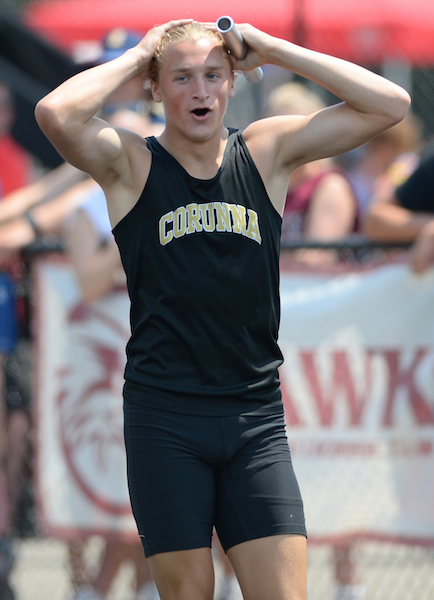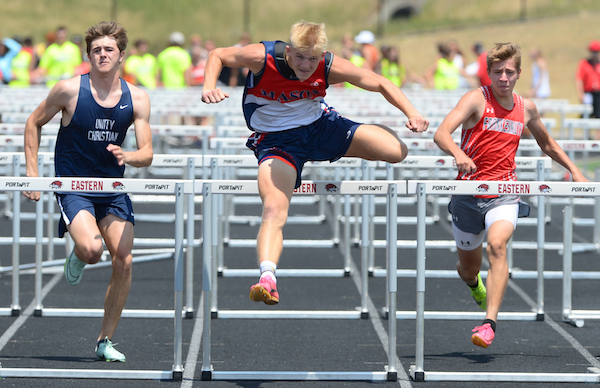
Hillsdale Begins March Toward Big June
By
Doug Donnelly
Special for MHSAA.com
April 3, 2018
HILLSDALE – The MHSAA Track & Field Finals are still a couple months, a few thunderstorms and maybe even some snow showers away.
 But, there’s once again one thing you can most likely count on – the Hillsdale Hornets boys track & field team will be well represented June 2 at Comstock Park High School.
But, there’s once again one thing you can most likely count on – the Hillsdale Hornets boys track & field team will be well represented June 2 at Comstock Park High School.
In Clay Schiman’s first season coaching the Hornets track team in 2013, Hillsdale scored three points at the Lower Peninsula Division 3 Finals meet. In 2014, Hillsdale made the big jump to a fourth-place finish. In each of the three seasons since, Hillsdale has finished second. In each of the past two seasons, they finished five points out of first place; Chesaning won the championship in 2017 and Sanford Meridian in 2016.
Schiman says it’s much too early to tell if the Hornets will have the depth and points to finish that high again. But, no one is counting Hillsdale out.
“It takes so many points in so many different areas to win that state meet,” Schiman said. “We haven’t set our team goals yet. We try and get a few meets under our belt first, then take a realistic look. I’d say we have a chance to score some points and have a few all-state athletes.”
That translates into a team to watch come June.
“Our kids value hard work, whether that is in the weight room or the classroom or learning technique,” Schiman said. “The kids know if they are going to be an athlete here, they are going to work.”
Hillsdale had eight seniors qualify for the boys meet last year, either in an individual event or relay. They have 33 out for track this season, which is slightly down from the last couple of seasons but enough to give the Hornets some depth and options when it comes to dual meets, Lenawee County Athletic Association events and invitationals.
“For a Division 3 school, we have a lot of options for kids,” he said. “It’s just about getting them out and motivating them. We don’t focus on winning every meet or invitational. It’s all about progressions and improving from one meet to the next or one year to the next.”
A good example of how an athlete can improve from one year to the next is what Rees Nemeth did last year for the Hornets. The pole vaulter went from 11-foot-6 as a junior to winning the LPD3 championship last year.
“Track is unique in that way,” Schiman said. “You never know who else is out there or who is going to take that leap from one year to the next.”
At the top of this year’s list of Hornets is junior Spencer Eves, the Division 3 high jump champion last year. He has a good track pedigree. His older brother was an all-state distance runner who now races in college. Spencer went 6-7 last year at the Finals.
“He was on the MITCA team, representing Michigan in the high jump,” Schiman said. “For a Division 3 athlete, that is really impressive. We are excited about his prospects and potential this year.”
Sam Nash was on the Division 3 championship 1,600 relay team in 2016 and will be in multiple events this year, including the 400.
“In his first event of this season he was right where he left off in June,” Schiman said. “That doesn’t happen very often. It was a great start to the season.”
Hurdlers Noah LoPresto and Colby Nash have a ton of potential and Ryan Reiniche is one of those athletes that Schiman expects to make great strides. Reiniche is a discus thrower.
“He finished (last) season really strong,” the Hillsdale coach said.
Hillsdale began this spring like it has for the last several years – at the Charger Preview, hosted annually by Hillsdale College. Hillsdale High uses that meet as a barometer for the season. The school is on spring break next week, meaning the athletes will have a week of working out on their own before returning to action the first full week in April.
“It’s great for us,” he said. “It sets the tone for the whole year. Twenty teams were there competing, so you know, in every event, you are going to get some good competition. It’s good for all of the kids who go to that meet.”
Hillsdale made some strides, Schiman said. Now, its up to the athletes to keep working, improve each week and be prepared for the big stage come June, whether it’s raining, windy or 85 degrees and sunshine.
“We believe in our program and what we are doing,” Schiman said.
 Doug Donnelly has served as a sports and news reporter and city editor over 25 years, writing for the Daily Chief-Union in Upper Sandusky, Ohio from 1992-1995, the Monroe Evening News from 1995-2012 and the Adrian Daily Telegram since 2013. He's also written a book on high school basketball in Monroe County and compiles record books for various schools in southeast Michigan. E-mail him at [email protected] with story ideas for Jackson, Washtenaw, Hillsdale, Lenawee and Monroe counties.
Doug Donnelly has served as a sports and news reporter and city editor over 25 years, writing for the Daily Chief-Union in Upper Sandusky, Ohio from 1992-1995, the Monroe Evening News from 1995-2012 and the Adrian Daily Telegram since 2013. He's also written a book on high school basketball in Monroe County and compiles record books for various schools in southeast Michigan. E-mail him at [email protected] with story ideas for Jackson, Washtenaw, Hillsdale, Lenawee and Monroe counties.
PHOTO: Hillsdale's Spencer Eves competes in the high jump last season.

Vicksburg's Wright, Corunna Right On in Claiming LPD2 Championships
By
Steve Vedder
Special for MHSAA.com
June 3, 2023
ADA – If Michael Wright was a baseball player, he probably would've been called out on strikes a year ago.
Instead, the Vicksburg senior can celebrate after winning the 200 at Saturday's Lower Peninsula Division 2 Track & Field Finals at Forest Hills Eastern.
The road to the championship in the 200, via a time of 21.72, was anything but a straight line for Wright. An aspiring baseball player, he was cut from the Vicksburg squad as a freshman. His football career, by Wright's own admission, was "on and off." And then a year ago in his first track meet, Wright suffered a leg injury that virtually ended his season. He did return to finish fifth in the 200 at Finals while helping the 400 relay team to a 16th place.
So there is nothing to realistically explain how Wright found himself in the position Saturday at sweltering Forest Hills Eastern to win a championship. Except for returning this season to break the school record in the 200 four times in two months. Well, that and willpower and simple desire.
 "I knew I could finish high, maybe in the top five. But this is better," said Wright, who credits drinking large quantities of milk for his resurgence. "I looked to football because I didn't think I could bounce back for track. But I overcame the bumps, the obstacles."
"I knew I could finish high, maybe in the top five. But this is better," said Wright, who credits drinking large quantities of milk for his resurgence. "I looked to football because I didn't think I could bounce back for track. But I overcame the bumps, the obstacles."
While Wright was jump-starting his track career, Corunna won the team title with 41 points. Mason and Forest Hills Eastern tied for second with 35. Whitehall was fourth with 33 points, and Frankenmuth fifth with 29 points.
Corunna coach Jeff Sawyer, who had never won a Finals title in 37 years coaching at Owosso and three more at Corunna, said the championship came after little fanfare during the season. Virtually right up until the time Corunna hauled off its first-place trophy, Sawyer said it was never really on his team's mind. The title came after the team managed only a runner-up finish at the Regional.
"We kind of low-keyed it," he said. "We knew scoring 40 points was possible. We lost to Frankenmuth by one point at the Regional. … We were a little disappointed we didn't win, but we had some good times today. We knew it was possible.
"Every day we just come and do what we do. We talk about getting better every day with PRs (personal records). And we're still getting better because we have some tough guys. Just competitive, tough kids. But we were the underdogs."
Corunna had only two firsts on Saturday, in the 400 relay (42.63) and Wyatt Bower in the long jump (22-8½).
Among the individual highlights was Frankenmuth senior Dalton DeBeau, who successfully defended his Finals title in the discus (171-6). He was fifth in that event as a sophomore and after winning a year ago, was considered a good bet to repeat.
"I kind of expected it," said DeBeau, who will compete at Michigan State next spring. "There wasn't a lot of pressure. I knew what had to be done. I threw 160 feet on my first throw to get in the finals, and that helped right away. I knew I could go all out."
 Berrien Springs' Jake Machiniak won the 100 (10.54) while the team also captured the 800 relay (1:28.18). Machiniak said his season hasn't been without its share of difficulties. There was a time when he couldn't seem to come out of the starting blocks smoothly. But beginning with the conference meet where he ran school record 10:73, Machiniak felt himself back on course.
Berrien Springs' Jake Machiniak won the 100 (10.54) while the team also captured the 800 relay (1:28.18). Machiniak said his season hasn't been without its share of difficulties. There was a time when he couldn't seem to come out of the starting blocks smoothly. But beginning with the conference meet where he ran school record 10:73, Machiniak felt himself back on course.
"There were ups and downs. I struggled in the middle of the season," he said. "But my teammates helped me through some difficulties. I came here to finish the job; I knew I could do something here."
Mason's Tyler Baker won the 100 hurdles (14.63) to complete a long journey that included finishing just ninth in last year's prelims. The success was as simple as putting in loads of offseason work.
"I practiced and did stuff about every day," he said. "I might not be the fastest, but I make up for that in form. It's a fine-tuning thing. Everyone wants to be faster."
Mason also got a championship from A.J. Mantel, who captured the 300 hurdles (38.90).
Among other highlights was Forest Hills Eastern senior Aiden Sullivan successfully defending a 2022 title on his own home turf. He won Saturday's 800 (1:53.92).
Adrian won the 3,200 relay (7:39.77), while Grand Rapids Christian took the 1,600 (3:24.49).
Alma had two individual winners in Michael Howey in the shot (55-08) and Jacob Dunlap in the high jump (6-7).
The other champs were Kyle Eberhard of Linden in the 1,600 (4:14.79), Whitehall's Trannon Ayler in the 400 (48.83), Freeland's T.J. Hansen in the 3,200 (9:11.56) and Sam Vesperman of Grosse Ile in the pole vault (15.01). Chelsea senior Jacob Nelson competed in the adaptive 100 (27.28), 200 (57.71) and shot put (6-6).
PHOTOS (Top) Vicksburg's Michael Wright celebrates after winning the 200 on Saturday. (Middle) Corunna's Tarick Bower enjoys a moment after anchoring the winning 400 relay. (Below) Mason's Tyler Baker, center, works to stay ahead in the 110 hurdles. (Photos by Dave McCauley/RunMichigan.com.)

